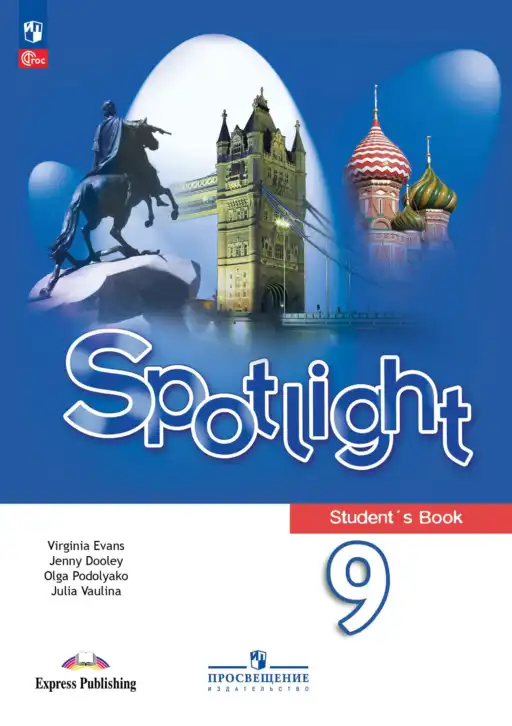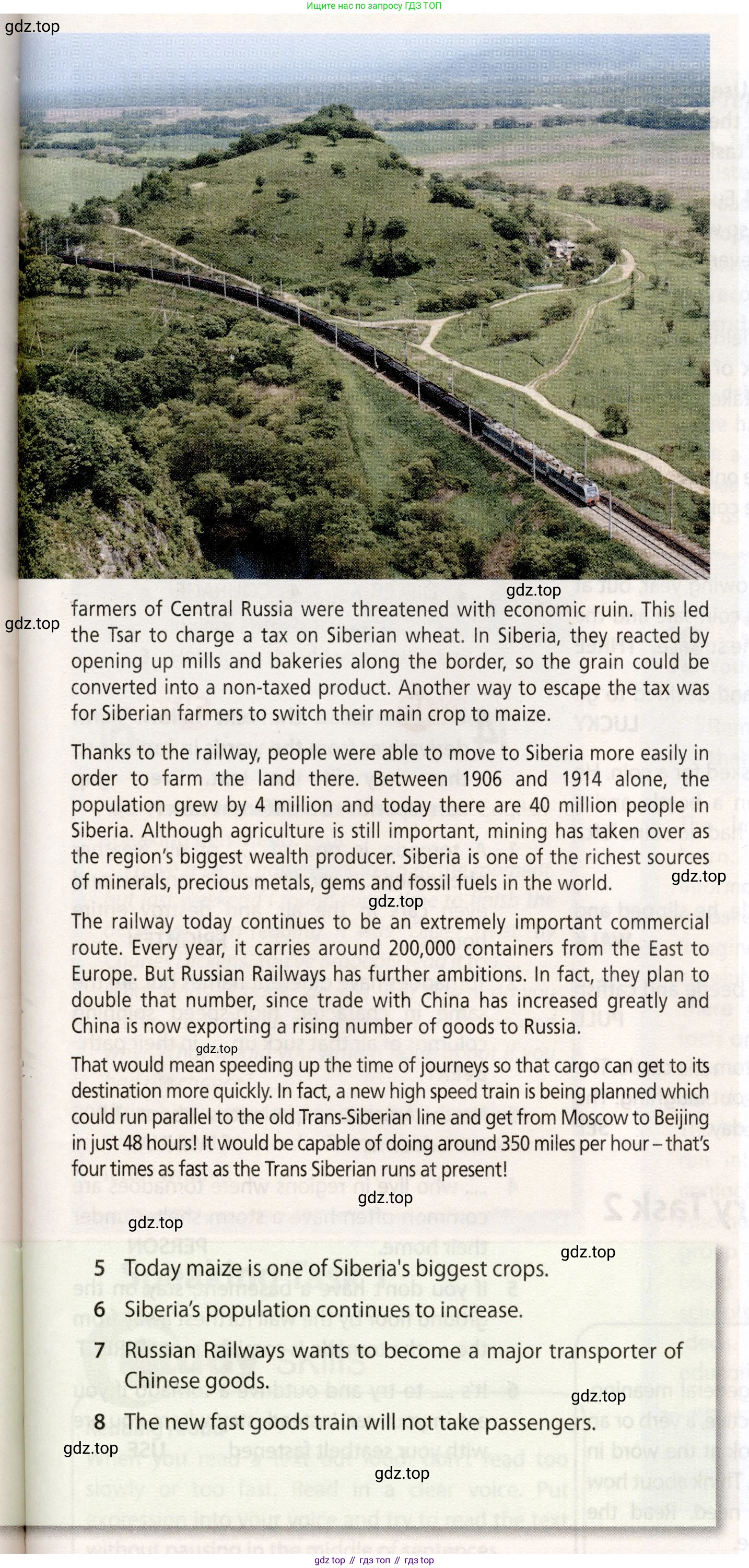Номер 10, страница 158 - гдз по английскому языку 9 класс (spotlight) учебник Ваулина, Дули

Авторы: Ваулина Ю. Е., Дули Д., Подоляко О. Е., Эванс В.
Тип: Student's book (Учебник)
Серия: spotlight (английский в фокусе)
Издательство: Просвещение, Express Publishing
Год издания: 2023 - 2025
Цвет обложки: белый, синий с Тауэрским мостом
ISBN: 978-5-09-102412-8
Допущено Министерством просвещения Российской Федерации
Популярные ГДЗ в 9 классе
Exam Practice Section - номер 10, страница 158.
№10 (с. 158)
Это задание совпадает в старом и новом учебнике.
Условие 2019-2022. №10 (с. 158)
скриншот условия


10 RNE Read the text. Decide which of the statements (1-8) are T (True), F (False) or NS, meaning that you can't give a clear answer to them (Not Stated). Write down the number you think is the right answer in the box.
The longest rail journey
‘The Trans-Siberian is the big train ride. All the rest are peanuts.’
Eric Newby, The Big Red Train Ride
Russia is by far the largest country in the world, stretching east to west across two continents, sixteen time zones and over 10,000 km. That’s why it has the longest railway in the world – the Trans-Siberian Railway, which connects Saint Petersburg with Vladivostok on the Sea of Japan, over 9,500 km away. Over 150 years old, it is still a main connection, with plans to make it an indispensable part of East-West trade.
Though mainly a freight train, carrying goods from the East to Russia and the rest of Europe, it has long attracted the more daring traveller. For seven days passengers sit in their carriages, staring out as the train crosses mighty rivers like the Volga, skirts mountain ranges like the Urals and pulls across the seemingly endless Siberian Steppes. Such a journey is not for everyone!
As Siberia developed in the late 1800s, the need for such a railway was created. Though the huge empty lands had enormous potential for agriculture, roads were few and those that did exist were often impassable during the spring thaw or during the savagely cold Siberian winters – people usually got around by river – and on the ice of those same rivers during the winter months. Instead, future Tsar Nicholas II started building the railway in Vladivostok in March 1880.
Soon tracks began to be laid in the west, too, the plan being to meet in the centre. In 1890, a bridge was built across the Ural River and the western half of the railway entered Asia. The bridge across the river Ob was constructed in 1898, and in the same year the first train reached Irkutsk on the shores of Lake Baikal. But it was not until 1916 that the final section was completed, just north of the border with China, and Saint Petersburg and Vladivostok were finally joined.
The railway soon formed a successful link between Siberia and Central and European Russia, both physically and economically. It was, in fact, too successful. So much cheap grain started flooding the west that the farmers of Central Russia were threatened with economic ruin. This led the Tsar to charge a tax on Siberian wheat. In Siberia, they reacted by opening up mills and bakeries along the border, so the grain could be converted into a non-taxed product. Another way to escape the tax was for Siberian farmers to switch their main crop to maize.
Thanks to the railway, people were able to move to Siberia more easily in order to farm the land there. Between 1906 and 1914 alone, the population grew by 4 million and today there are 40 million people in Siberia. Although agriculture is still important, mining has taken over as the region’s biggest wealth producer. Siberia is one of the richest sources of minerals, precious metals, gems and fossil fuels in the world.
The railway today continues to be an extremely important commercial route. Every year, it carries around 200,000 containers from the East to Europe. But Russian Railways has further ambitions. In fact, they plan to double that number, since trade with China has increased greatly and China is now exporting a rising number of goods to Russia.
That would mean speeding up the time of journeys so that cargo can get to its destination more quickly. In fact, a new high speed train is being planned which could run parallel to the old Trans-Siberian line and get from Moscow to Beijing in just 48 hours! It would be capable of doing around 350 miles per hour – that’s four times as fast as the Trans Siberian runs at present!
1 One end of the Trans-Siberian Railway is on the coast.
2 Only certain kinds of tourists would enjoy the rail journey across Siberia.
3 Before the railway, travel was impossible in Siberia in winter.
4 The bridge across the Ural took longer to build than the bridge across the Ob.
5 Today maize is one of Siberia’s biggest crops.
6 Siberia’s population continues to increase.
7 Russian Railways wants to become a major transporter of Chinese goods.
8 The new fast goods train will not take passengers.
Условие 2023-2027. №10 (с. 158)
скриншот условия


10 RNE Read the text. Decide which of the statements (1-8) are T (True), F (False) or NS (Not Stated). Write down the number you think is the right answer in the box.
The longest rail journey
‘The Trans-Siberian is the big train ride. All the rest are peanuts.’
Eric Newby, The Big Red Train Ride.
Russia is by far the largest country in the world, stretching east to west across two continents, sixteen time zones and over 10,000 km. That’s why it has the longest railway in the world – the Trans-Siberian Railway, which connects Moscow with Vladivostok on the Sea of Japan, over 9,500 km away. Over 150 years old, it is still a main connection, with plans to make it an indispensable part of East-West trade.
Though mainly a freight train, carrying goods from the East to Russia and the rest of Europe, it has long attracted the more daring traveller. For seven days passengers sit in their carriages, staring out as the train crosses mighty rivers like the Volga, skirts mountain ranges like the Urals and pulls across the seemingly endless Siberian Steppes. Such a journey is not for everyone!
As Siberia developed in the late 1800s, the need for such a railway was created. Though the huge empty lands had enormous potential for agriculture, roads were few and those that did exist were often impassable during the winter months. Instead, people usually got around by river – and on the ice of those same rivers during the savagely cold Siberian winters – but this was not an ideal solution. In March 1880, future Tsar Nicholas II started building the railway in Vladivostok.
Soon tracks began to be laid in the west, too, the plan being to meet in the centre. In 1890, a bridge was built across the Ural River and the western half of the railway entered Asia. The bridge across the river Ob was constructed in 1898, and in the same year the first train reached Irkutsk on the shores of Lake Baikal. But it was not until 1916 that the final section was completed, just north of the border with China, and Moscow and Vladivostok were finally joined.
The railway soon formed a successful link between Siberia and Central and European Russia, both physically and economically. It was, in fact, too successful. So much cheap grain started flooding the west that the farmers of Central Russia were threatened with economic ruin. This led the Tsar to charge a tax on Siberian wheat. In Siberia, they reacted by opening up mills and bakeries along the border, so the grain could be converted into a non-taxed product. Another way to escape the tax was for Siberian farmers to switch their main crop to maize.
Thanks to the railway, people were able to move to Siberia more easily in order to farm the land there. Between 1906 and 1914 alone, the population grew by 4 million and today there are 25 million people in Siberia. Although agriculture is still important, mining has taken over as the region’s biggest wealth producer. Siberia is one of the richest sources of minerals, precious metals, gems and fossil fuels in the world.
The railway today continues to be an extremely important commercial route. Every year, it carries around 200,000 containers from the East to Europe. But Russian Railways has further ambitions. In fact, they plan to double that number, since trade with China has increased greatly and China is now exporting a rising number of goods to Russia.
That would mean speeding up the time of journeys so that cargo can get to its destination more quickly. In fact, a new high-speed train is being planned which could run parallel to the old Trans-Siberian line and get from Moscow to Beijing in just 48 hours! It would be capable of doing around 350 miles per hour – that’s 2.5 times as fast as the Trans-Siberian runs at present!
1 One end of the Trans-Siberian Railway is on the coast.
2 Only certain kinds of tourists would enjoy the rail journey across Siberia.
3 Before the railway, travel was impossible in Siberia in winter.
4 The bridge across the Ural took longer to build than the bridge across the Ob.
MOSCOW
Yekaterinburg
Novosibirsk
Irkutsk
Lake Baikal
Khabarovsk
Vladivostok
5 Today maize is one of Siberia’s biggest crops.
6 Siberia’s population continues to increase.
7 Russian Railways wants to become a major transporter of Chinese goods.
8 The new fast goods train will not take passengers.
Решение 2023-2027. №10 (с. 158)



Решение 2 2023-2027. №10 (с. 158)
Прочитайте текст. Определите, какие из утверждений (1-8) являются T (Истина), F (Ложь) или NS (Не указано).
Ответ:
1 T (True) - One end of the Trans-Siberian Railway is on the coast. / T (Истина) - Один конец Транссибирской магистрали находится на побережье.
2 T (True) - Only certain kinds of tourists would enjoy the rail journey across Siberia. / T (Истина) - Только определенным туристам понравится путешествие по железной дороге через Сибирь.
3 F (False) - Before the railway, travel was impossible in Siberia in winter. / F (Ложь) - До появления железной дороги путешествовать по Сибири зимой было невозможно.
4 NS (Not Stated) - The bridge across the Ural took longer to build than the bridge across the Ob. / NS (Не указано) - Строительство моста через Урал заняло больше времени, чем строительство моста через Обь.
5 NS (Not Stated) - Today maize is one of Siberia's biggest crops. / NS (Не указано) - Сегодня кукуруза является одной из крупнейших сельскохозяйственных культур Сибири.
6 NS (Not Stated) - Siberia's population continues to increase. / NS (Не указано) - Население Сибири продолжает расти.
7 T (True) - Russian Railways wants to become a major transporter of Chinese goods. / T (Истина) - Российские железные дороги хотят стать крупным перевозчиком китайских товаров.
8 NS (Not Stated) - The new fast goods train will not take passengers. / NS (Не указано) - Новый скорый товарный поезд не будет перевозить пассажиров.
Другие задания:
Помогло решение? Оставьте отзыв в комментариях ниже.
Присоединяйтесь к Телеграм-группе @top_gdz
ПрисоединитьсяМы подготовили для вас ответ c подробным объяснением домашего задания по английскому языку за 9 класс, для упражнения номер 10 расположенного на странице 158 к Учебник (Student's book) серии английский в фокусе , spotlight (спотлайт) 2023 года издания для учащихся школ и гимназий.
Теперь на нашем сайте ГДЗ.ТОП вы всегда легко и бесплатно найдёте условие с правильным ответом на вопрос «Как решить ДЗ» и «Как сделать» задание по английскому языку к упражнению №10 (с. 158), авторов: Ваулина (Юлия Евгеньевна), Дули (Дженни ), Подоляко (Ольга Евгеньевна), Эванс (Вирджиния ), ФГОС (новый, красный) учебного пособия издательства Просвещение, Express Publishing.














